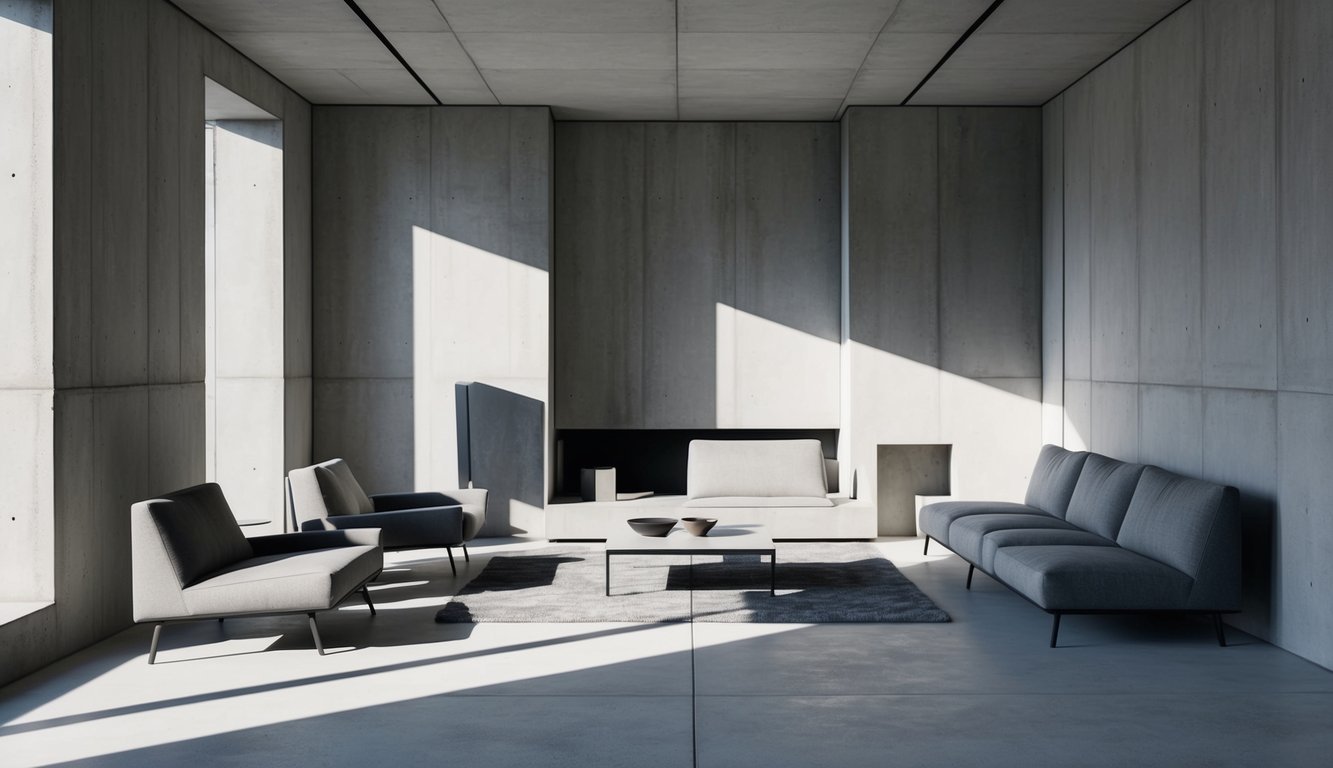Jan 22, 2025
•
Onton Team
Discover the essence of brutalist interior design, where raw materials and minimalist aesthetics create bold, functional spaces that celebrate stark beauty.
Brutalist interior design boldly embraces raw materials and stark forms. This striking aesthetic emerged from the mid-20th century architectural movement, celebrating the honesty of exposed structures and unadorned surfaces.
Brutalist interiors feature exposed concrete, geometric shapes, and a minimalist approach that emphasizes functionality over ornamentation.
You'll find brutalist spaces characterized by their use of bare concrete, metal, and glass. These materials are often left in their natural state, showcasing their inherent textures and imperfections.
The style favors clean lines, monochromatic color schemes, and sculptural elements that make a strong visual impact.
When incorporating brutalist design into your home, focus on creating contrast through textures and materials. Mix rough concrete walls with sleek metal fixtures or soften hard edges with organic shapes and natural elements.
This approach allows you to create a space that feels both dramatic and livable.
Key Takeaways
Brutalist interiors emphasize raw materials and minimalist aesthetics for a bold, functional space
Exposed concrete, metal, and geometric shapes are key elements of the brutalist style
You can soften brutalist designs by incorporating contrasting textures and organic elements
What Is Brutalist Interior Design?

Brutalist interior design is a bold and distinctive style that emerged from the architectural movement of the mid-20th century. It draws inspiration from the raw, exposed materials and monolithic forms seen in brutalist buildings.
You'll recognize brutalist interiors by their use of bare concrete, exposed brick, and metal surfaces. These spaces celebrate the inherent beauty of materials in their natural state.
Functionality takes center stage in brutalist design. You'll find minimal ornamentation and a focus on practical, no-frills elements.
The aesthetic is characterized by:
Strong geometric shapes
Textural contrasts
Monochromatic color schemes
Exposed structural elements
Brutalist interiors often feature sculptural furniture pieces and lighting fixtures that serve as focal points. You might see chunky concrete tables or metal chairs with striking silhouettes.
Lighting plays a crucial role in brutalist spaces. Dramatic shadows and carefully placed accent lights help highlight the textures and forms of the raw materials.
While often perceived as cold or austere, brutalist interiors can be softened with strategic use of textiles, plants, or artwork. These elements add warmth and personality without compromising the style's core principles.
Brutalist interior design challenges conventional notions of comfort and beauty. It invites you to appreciate the honesty of materials and the power of unadorned forms.
History and Origins of Brutalist Design
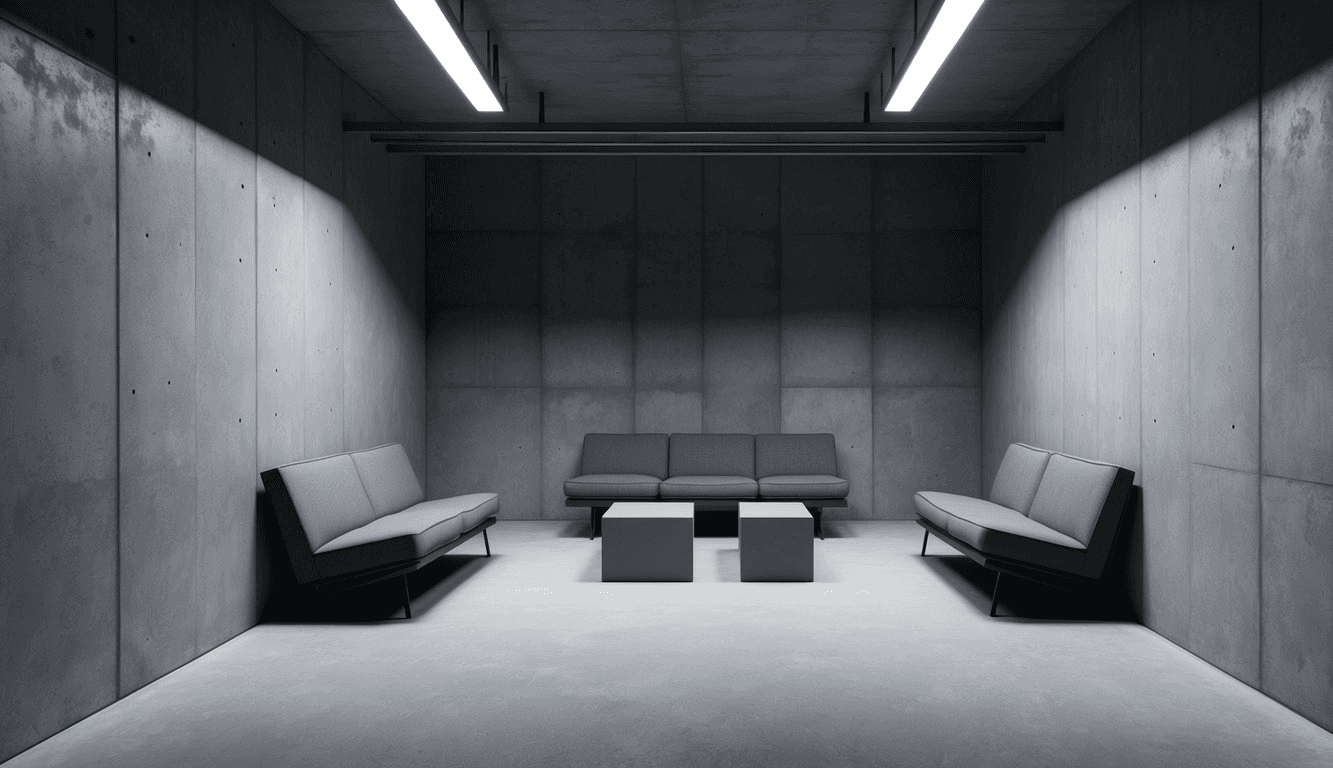
Brutalist design emerged as an architectural movement in the 1950s. It gained popularity during the 1960s and 1970s as a reaction to the decorative styles of mid-century modernism.
The term "brutalism" comes from the French "béton brut," meaning raw concrete. This material became a signature element of the style, prized for its honest expression of structure and materiality.
Brutalist architecture is characterized by bold, monolithic forms and exposed building materials. You'll often see rough concrete surfaces, geometric shapes, and a celebration of functional elements.
The movement was influenced by earlier modernist architects and the Bauhaus school. It sought to create buildings that were functional, affordable, and reflective of post-war society's values.
Famous examples of brutalist interiors include the Barbican Centre in London. This iconic complex showcases the style's emphasis on raw materials and sculptural forms within interior spaces.
Brutalism's impact extended beyond architecture into interior design. You'll find brutalist interiors feature exposed concrete, minimalist furnishings, and an emphasis on texture and materiality.
While the style faced criticism in later decades, it has experienced a resurgence of interest in recent years. Many appreciate its bold aesthetic and connection to mid-20th century ideals.
Brutalist Influence on Interior Design
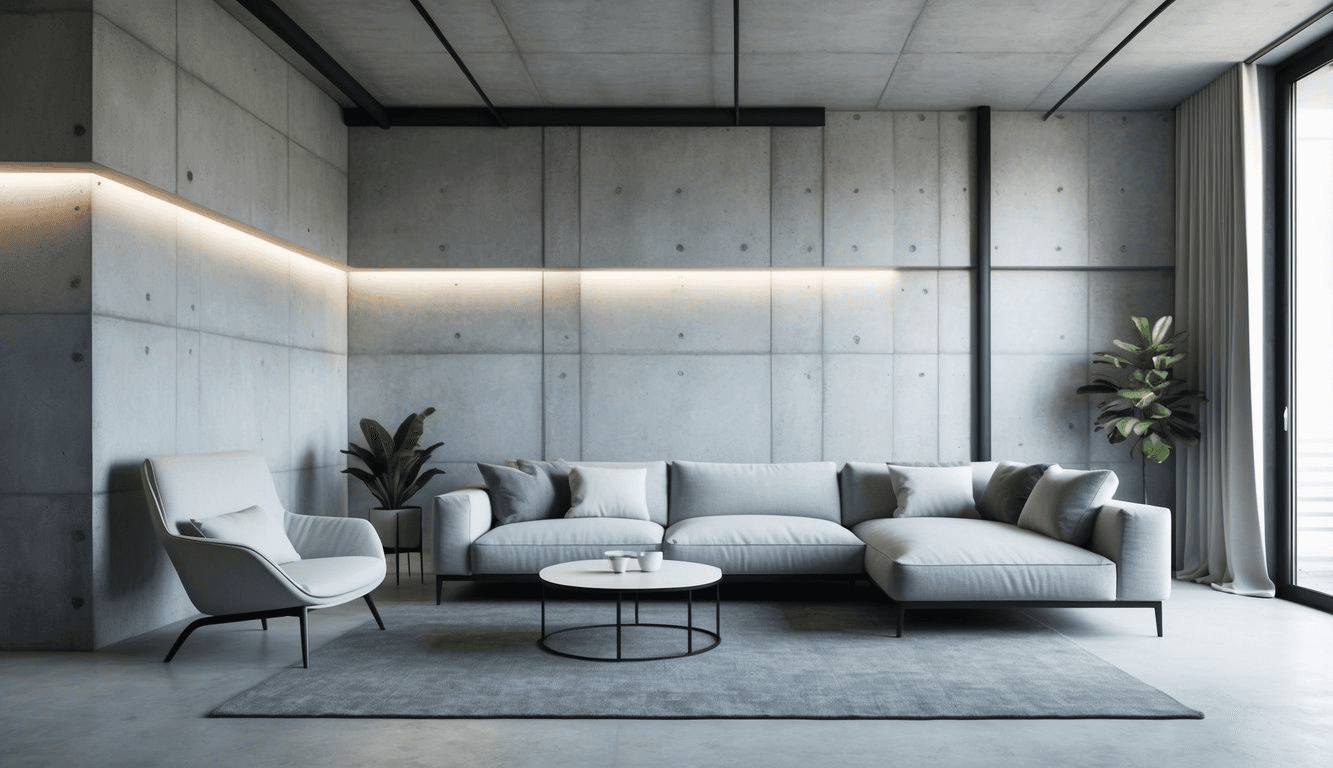
Brutalist interior design emerged as a powerful force in the 1950s, leaving an indelible mark on spaces worldwide. This bold style emphasizes raw materials and unadorned surfaces, creating stark yet striking environments.
In brutalist interiors, you'll find exposed concrete, rough textures, and monolithic forms. These elements create a sense of honesty and authenticity in the space, allowing materials to speak for themselves.
The influence of brutalism extends beyond just concrete. You'll often see:
Blocky, geometric furniture
Bare brick walls
Exposed structural elements
Minimal ornamentation
Brutalist design makes a strong architectural statement. It challenges conventional notions of comfort and luxury, favoring a more rugged and industrial aesthetic.
Color palettes in brutalist interiors tend to be muted and monochromatic. Shades of gray, beige, and earth tones dominate, punctuated by occasional bold accents.
Lighting plays a crucial role in brutalist spaces. You'll notice dramatic shadows and contrasts, often created by strategically placed windows or sculptural light fixtures.
Brutalism's influence on interior design continues to resonate today. Many contemporary designers incorporate brutalist elements to add depth and character to modern spaces.
Key Elements of Brutalist Interior Design
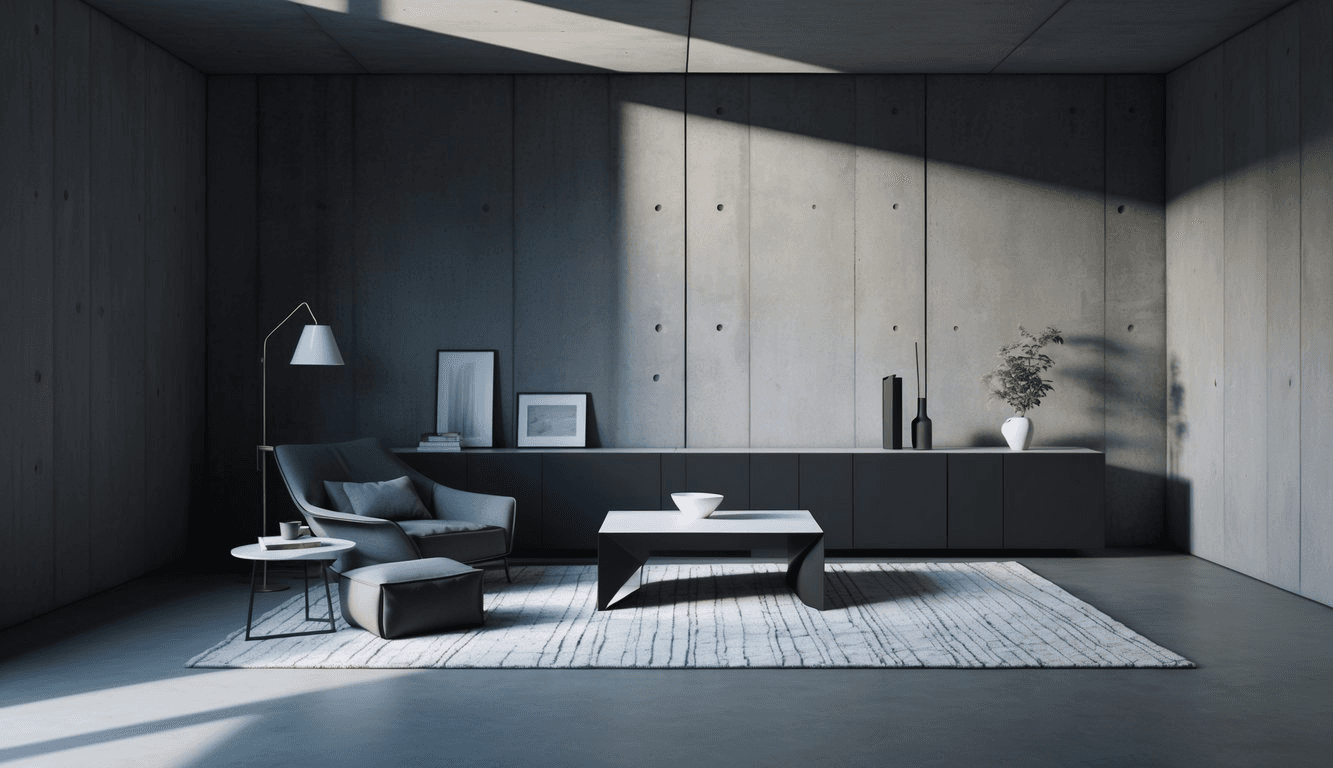
Brutalist interior design embraces raw materials, bold forms, and functional aesthetics. It emphasizes honesty in construction and celebrates the inherent beauty of unadorned elements.
Raw Material Expression
Concrete reigns supreme in brutalist interiors. Exposed concrete walls, floors, and ceilings showcase the material's raw beauty and texture. You'll often see béton brut or "raw concrete" with visible formwork patterns and imperfections left intact.
Steel and glass also play prominent roles. Exposed steel beams, columns, and ductwork highlight structural elements. Large glass panes create contrast and allow natural light to interact with concrete surfaces.
Wood, when used, is often left unfinished to highlight its natural grain and color. Stone may be incorporated in rough-hewn blocks or polished slabs.
Structural Transparency
Brutalist design embraces honesty in construction. You'll find exposed structural elements like beams, columns, and load-bearing walls proudly displayed. This transparency extends to mechanical and electrical systems, with pipes, ducts, and conduits often left visible.
Staircases become sculptural focal points, their concrete or steel forms emphasizing functionality and movement. Open floor plans further reinforce the sense of structural clarity, allowing you to perceive the building's inner workings.
Light and Shadow Play
Brutalist interiors leverage the interplay of light and shadow to dramatic effect. Large windows and skylights allow natural light to wash over rough concrete surfaces, highlighting textures and creating ever-changing patterns throughout the day.
Artificial lighting is often stark and purposeful. You might see exposed bulbs, industrial-style fixtures, or recessed lighting that casts dramatic shadows. The goal is to enhance the raw beauty of materials and emphasize sculptural forms.
Modular Repetition
Geometric shapes and modular elements are key to brutalist design. You'll notice repetitive patterns in concrete forms, window arrangements, and architectural details. This repetition creates visual rhythm and reinforces the sense of order and structure.
Furniture and decor often follow suit, with modular seating units, cubic storage systems, and grid-like shelving. These elements echo the architectural forms and contribute to the overall cohesive aesthetic.
Minimalist Color Palette
Brutalist interiors typically favor a restrained color palette. The natural hues of concrete, steel, and wood dominate. Greys, whites, and earth tones create a monochromatic backdrop that emphasizes form and texture over color.
When accent colors are used, they're often bold and impactful. A single piece of vibrantly colored furniture or artwork can provide striking contrast against the neutral surroundings.
Textural Contrasts
While brutalist design embraces rawness, it also plays with textural contrasts. Rough concrete might be juxtaposed with smooth glass or polished metal. You might find sleek leather seating against a rugged stone wall, or soft textiles draped over angular furniture.
These contrasts add depth and visual interest to the space. They invite touch and highlight the diverse material qualities within the brutalist aesthetic.
Monumental Forms
Brutalist interiors often feature bold, monumental forms. Chunky concrete staircases, massive fireplaces, or oversized built-in furniture become sculptural elements in their own right. These large-scale features create a sense of weight and permanence.
Asymmetrical compositions and unexpected angles add drama and visual interest. You might encounter cantilevered elements, split-level spaces, or unconventional room layouts that challenge traditional notions of interior design.
Substyles of Brutalist Interior Design
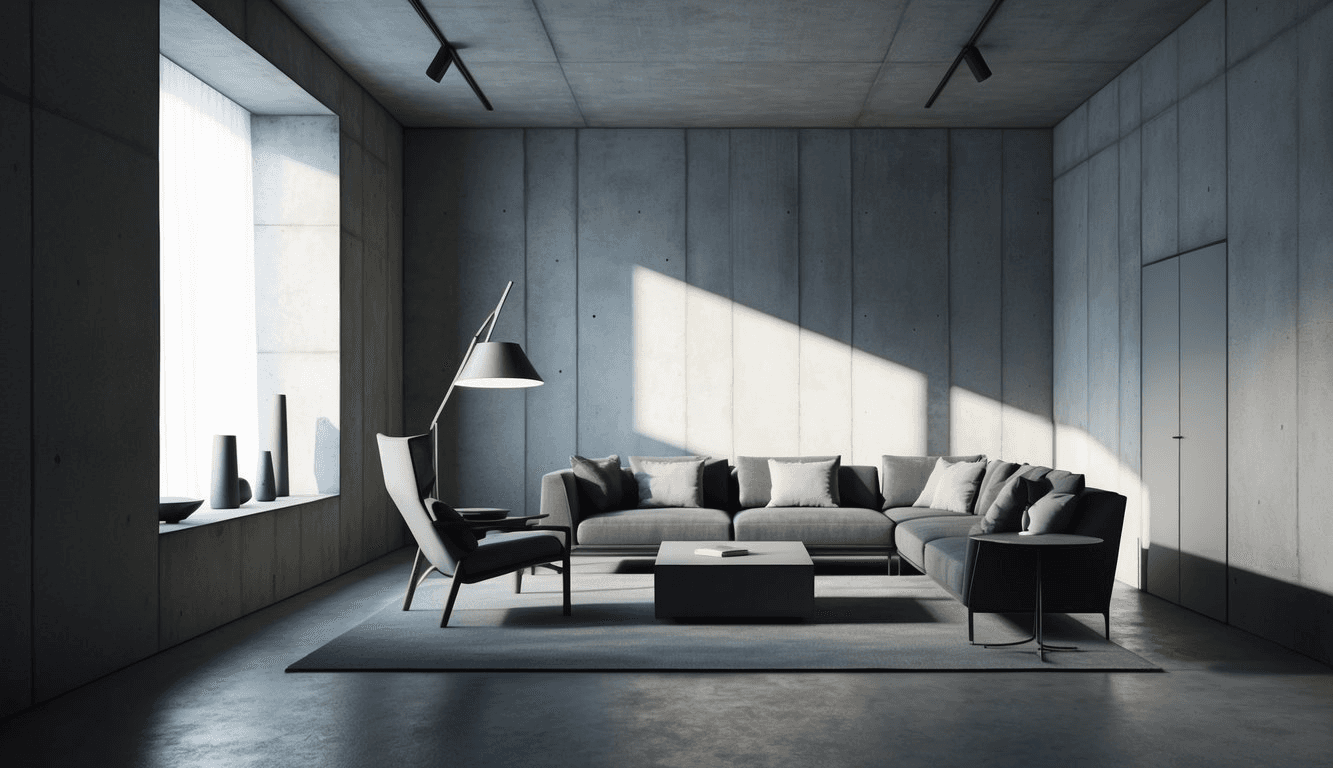
Brutalist interior design encompasses several distinct substyles, each with its own unique characteristics and interpretations of the core brutalist principles. These variations allow for greater flexibility in applying brutalist aesthetics to different spaces and preferences.
Traditional Brutalism
Traditional brutalist interiors stay true to the movement's origins. You'll find exposed concrete walls, floors, and ceilings dominating these spaces. The color palette is predominantly gray, with occasional pops of muted colors. Furniture pieces are often blocky and monolithic, mirroring the architectural elements.
Raw materials like steel, glass, and wood complement the concrete surfaces. Lighting fixtures tend to be industrial and minimalist. You'll notice a lack of ornamentation, with the focus on highlighting the inherent beauty of materials and structural elements.
Soft Brutalism
Soft brutalism softens the harsh edges of traditional brutalist design. You'll see a blend of brutalist elements with warmer materials and textures. Concrete surfaces may be paired with plush fabrics, natural wood, or leather.
The color palette expands to include earthy tones and pastels. Curved forms in furniture and decor pieces balance out the angular brutalist architecture. Soft brutalism creates a more approachable and comfortable living space while maintaining the essence of brutalist design.
Industrial Brutalism
Industrial brutalism combines brutalist principles with industrial aesthetics. You'll encounter a raw, unfinished look with exposed pipes, ducts, and electrical conduits. Metal surfaces, particularly steel and iron, play a significant role alongside concrete.
The color scheme often includes metallic hues and rust tones. Salvaged industrial objects are repurposed as decorative elements or functional pieces. Lighting fixtures may feature Edison bulbs or metal cages. Industrial brutalism embraces the beauty of utility and celebrates the mechanics of a space.
Minimalist Brutalism
Minimalist brutalism merges brutalist aesthetics with minimalist principles. You'll find clean lines, uncluttered spaces, and a focus on essential elements. The color palette is typically neutral, with shades of white, gray, and black dominating.
Furniture pieces are simple and functional, often with geometric shapes. Textures are smooth and uniform. Concrete surfaces may be polished for a sleeker look. Minimalist brutalism creates a sense of calm through its pared-down approach to design.
Eco-Brutalism
Eco-brutalism introduces sustainable elements to brutalist interiors. You'll see a focus on natural materials like reclaimed wood, bamboo, or cork alongside concrete. Living walls or indoor gardens soften the harsh brutalist surfaces and improve air quality.
The color palette incorporates natural hues and earth tones. Eco-friendly materials and energy-efficient systems are integrated into the design. Eco-brutalism aims to balance the raw aesthetics of brutalism with environmental consciousness, creating spaces that are both visually striking and sustainable.
Room by Room Brutalist Design Ideas
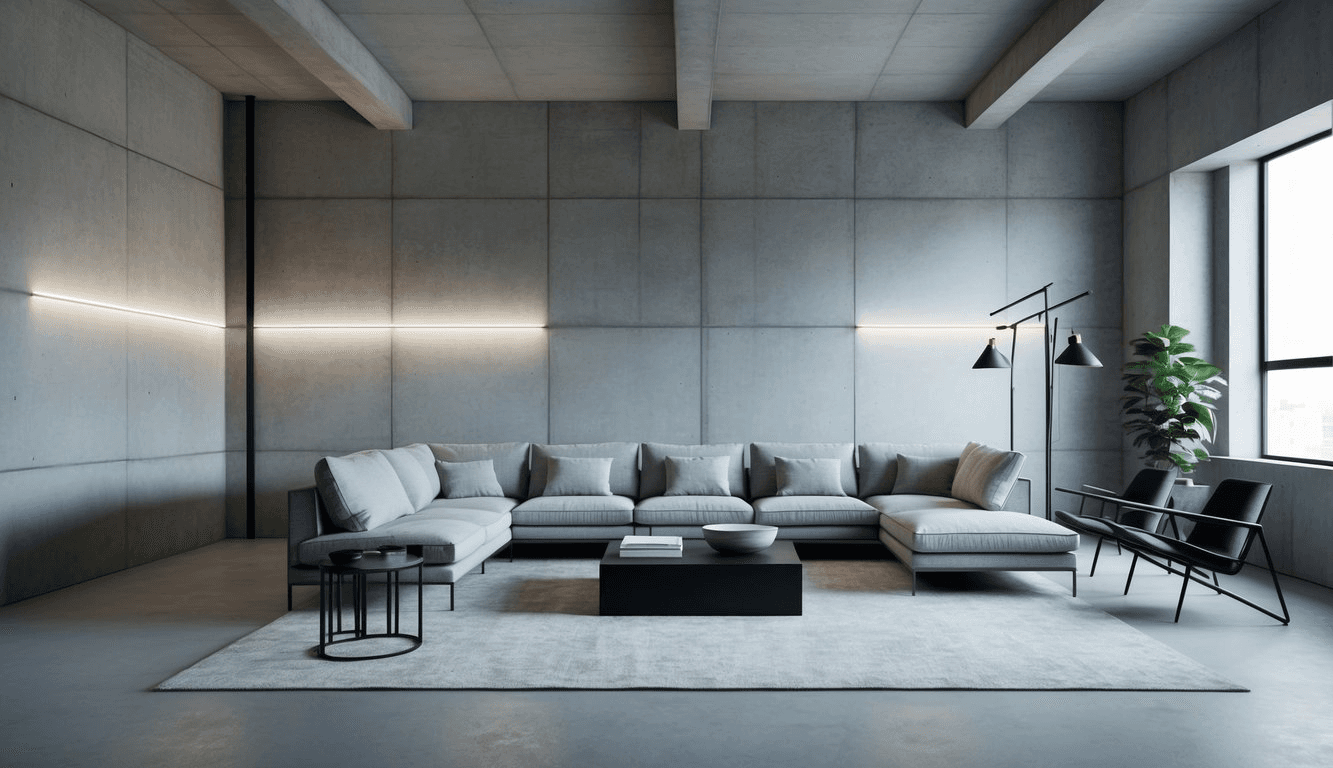
Brutalist design offers unique opportunities for each space in your home. By incorporating raw materials, bold forms, and industrial elements, you can create striking interiors that embody the essence of this architectural style.
Living Room
Transform your living room into a brutalist showcase with exposed concrete walls and floors. Choose a low-profile sofa in a neutral tone to complement the stark backdrop.
Add industrial-style lighting fixtures with geometric shapes to enhance the brutalist ambiance.
Incorporate a chunky concrete coffee table as a focal point. Display abstract art pieces on the walls to add visual interest. Use metal shelving units to showcase brutalist-inspired sculptures or books.
Soften the space with textured throw pillows and a plush area rug. Introduce warmth with wooden details like a reclaimed timber side table or bookshelf.
Place large potted plants in corners to bring life to the room.
Natural light is crucial in brutalist spaces. Install large windows or skylights to flood the room with sunlight. Use sheer curtains to filter light without compromising the brutalist aesthetic.
Kitchen
Create a brutalist kitchen by embracing raw materials and minimalist design. Opt for concrete countertops and backsplashes for a bold, industrial look.
Choose sleek, handleless cabinets in matte finishes to maintain clean lines. Install stainless steel appliances to complement the industrial vibe.
Use open shelving made from metal or concrete to display dishes and cookware. Add a large island with a concrete or metal top for extra workspace and seating.
Incorporate brutalist lighting with pendant lamps featuring geometric shapes or exposed bulbs. Use recessed lighting for task areas to maintain a clean ceiling line.
Install under-cabinet LED strips for functional illumination. Bring warmth to the space with wooden bar stools or a butcher block cutting board.
Add pops of color with small appliances or cookware in bold hues. Place herbs in concrete planters for a touch of greenery.
Bedroom
Design a brutalist bedroom that balances raw aesthetics with comfort. Start with exposed concrete walls or apply a concrete-effect paint.
Choose a low platform bed with a simple headboard in wood or upholstered in a neutral fabric. Use industrial-style bedside tables with metal frames and concrete tops.
Install wall-mounted reading lamps with adjustable arms for focused lighting. Add a large area rug in a geometric pattern to soften the floor.
Create contrast with crisp white bedding and textured throw pillows. Hang oversized abstract art pieces above the bed for visual impact.
Use blackout curtains in a heavy fabric to control light and add warmth. Incorporate a brutalist-inspired dresser or wardrobe with clean lines and a concrete finish.
Add greenery with large potted plants in concrete planters. Use a metal clothing rack as an alternative to a closet for an industrial touch.
Bathroom
Transform your bathroom into a brutalist retreat with bold materials and minimalist design. Install a concrete vanity with an integrated sink for a seamless look.
Choose a large mirror with a simple metal frame to reflect light and create the illusion of space. Opt for a walk-in shower with a glass partition and concrete walls.
Use large-format concrete-effect tiles on the floor and walls for a cohesive look. Install a rainfall showerhead for a luxurious touch.
Add warmth with wooden accents like a teak shower floor or toilet paper holder. Choose matte black fixtures for faucets, shower controls, and towel bars.
Use recessed lighting and wall sconces for a layered lighting scheme. Incorporate storage with floating concrete shelves or a metal storage ladder.
Display toiletries in sleek dispensers to maintain a clean aesthetic. Add a pop of color with vibrant towels or a bold shower curtain.
Home Office
Create a brutalist home office that promotes focus and creativity. Start with a concrete or concrete-effect desk as the centerpiece. Pair it with an ergonomic chair in leather or a neutral fabric.
Install floating concrete shelves for storage and display. Use metal filing cabinets or storage units for a industrial touch.
Add a large pinboard covered in burlap or linen for a tactile element. Maximize natural light with large windows or a skylight.
Use task lighting with adjustable desk lamps in metallic finishes. Install track lighting or recessed fixtures for overall illumination.
Incorporate plants to soften the space and improve air quality. Choose low-maintenance varieties in concrete or metal planters.
Add texture with a cowhide rug or a woven wall hanging. Display minimalist artwork or black-and-white photographs in simple frames.
Use cable management solutions to keep wires tidy and maintain clean lines. Add personal touches with concrete or metal desk accessories.
Why Choose Brutalist Design
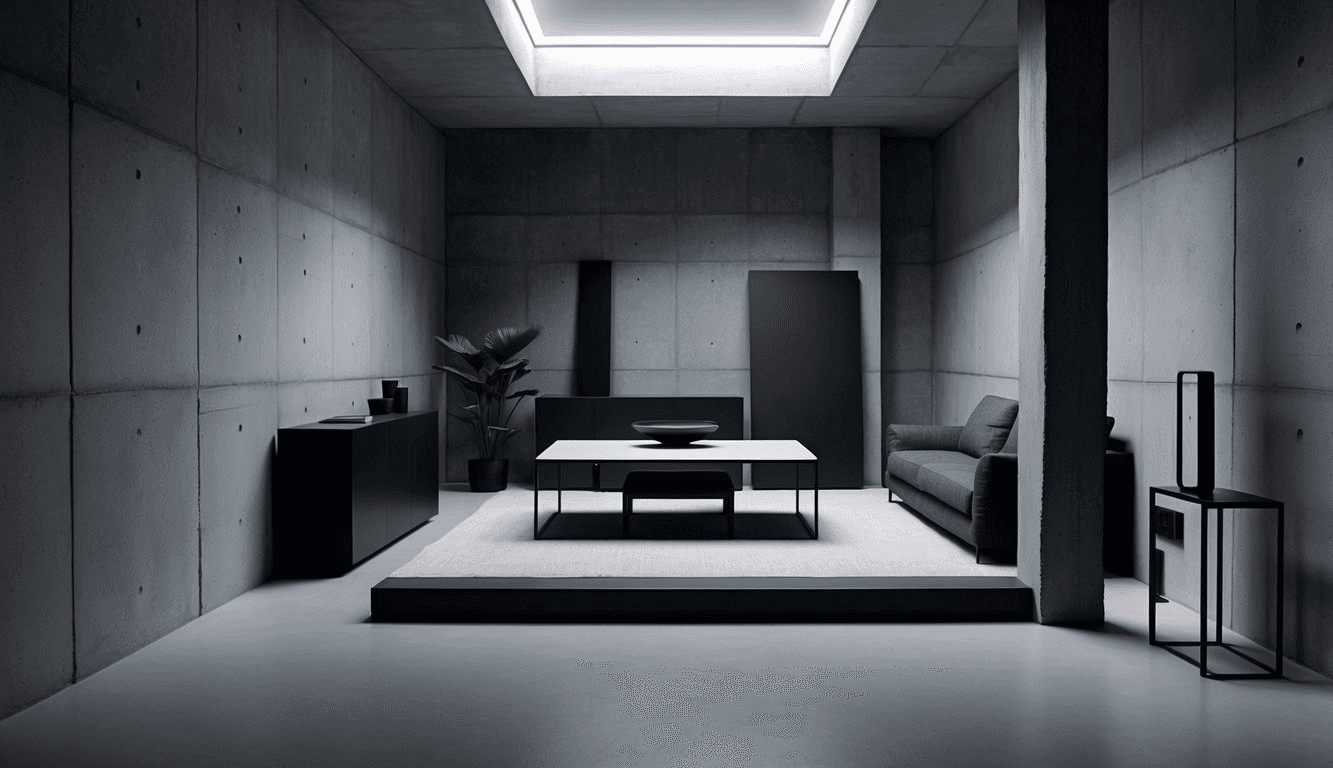
Brutalist interior design offers a bold and distinctive aesthetic for your space. Its raw, unadorned approach embraces simplicity and functionality at its core.
You'll find that brutalist elements create a powerful visual impact. Exposed concrete, bare metals, and geometric shapes make a striking statement in any room.
This style prioritizes honesty in materials. By showcasing the true nature of building components, you cultivate an authentic atmosphere free from pretense or artificial embellishments.
Brutalism aligns well with sustainable design principles. Its emphasis on durable, long-lasting materials reduces the need for frequent replacements or renovations.
Maintenance is often straightforward with brutalist interiors. The rugged surfaces and minimal ornamentation mean less upkeep is required to preserve the look.
You can appreciate the purity of form in brutalist spaces. Clean lines and uncluttered layouts allow the essential elements to shine without distraction.
Brutalist design adapts well to various environments. Whether in a home, office, or public space, its versatile nature can create impactful interiors.
By choosing brutalism, you make a confident design statement. It reflects a willingness to embrace unconventional beauty and challenge traditional notions of comfort.

